 The Best Robotic Pool Cleaners – Ratings and Buyer’s Guide
The Best Robotic Pool Cleaners – Ratings and Buyer’s Guide
If you want to know what the best robotic pool cleaners for 2023 are, you’ve come to the right place. You’ll find all the information you need to make an informed buying decision in this buyer’s guide, including ratings and reviews.
Our Top Picks
We select, test, review and suggest the best products. We may earn a commission, if you buy something through our links.
We have recommendations on pool robots for both in-ground and above-ground pools, how to choose the best robotic pool cleaner for your needs, why every automatic pool cleaner isn’t created equal, troubleshooting your pool robot, and so much more.
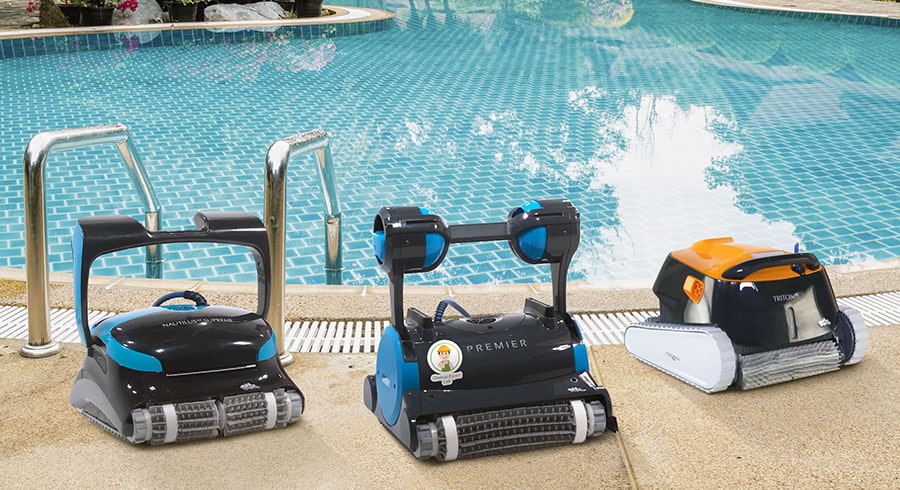
What To Look For In a Robot Pool Cleaner
A robotic pool vacuum is a totally self-contained electrically powered unit that works independently of your pool’s pump. They have motorized wheels or tank-like tire treads to firmly grip pool surfaces. Robot cleaners meticulously scrub the walls and waterline, capturing countless volumes of debris in their onboard filter canisters.

To find a pool cleaner that’s right for you, there are three main questions to ask:
- What kind of pool do you have?
- How much cleaning do you want to do?
- What features on a pool cleaner are most important to you?
How Robots Make Pool Maintenance Easier
Owning a pool can be a challenging and time-consuming responsibility. For starters, you need to vacuum the pool to get rid of all the yucky crud (possibly harboring disease-causing bacteria) at least once a week to make it safe for swimming. If you have oodles of leaf-producing trees on your property, you’ll probably have to significantly boost the frequency of your vacuuming.
Every pool has a dedicated filtration system that uses diatomaceous earth or another filter medium to get rid of fine particles. However, most of them don’t do an adequate job of getting rid of decaying organic matter such as rotten berries, nauseating bugs, and other nasty debris that can quickly accumulate in your backyard swimming hole. To eradicate this icky stuff, people in the past needed to expend herculean amounts of effort by manually cleaning their pools.
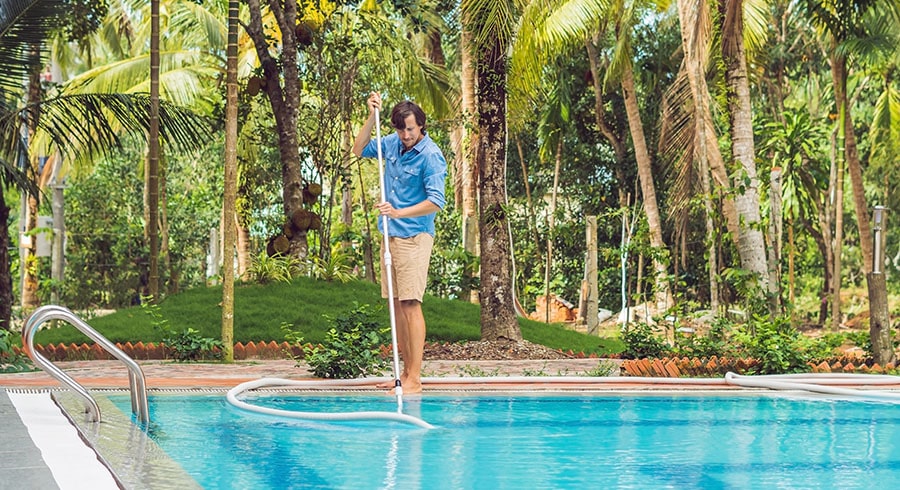
This could sometimes prove to be a Sisyphean task. For example, an owner who just vacuumed their pool could find that a huge wind gust deposited a truckload of leaves in it. This could demoralize even the most positive of human beings.
While no one in their right mind wants a disgustingly filthy pool, cleaning a pool by hand was always an arduous and time-consuming task. This caused legions of pool owners to not give their pool the love and attention it needed to keep it sparkling clean at all times. However, all that changed with the advent of automatic pool cleaners. These handy dandy machines are a godsend, making pool maintenance a breeze (for the most part).
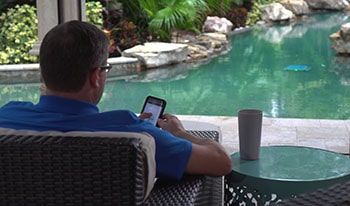
A New Age of Automation
Automatic pool cleaners ushered pool cleaning into a new, technologically sophisticated age, where formerly tedious household tasks were made less so through automation. A pool robot cleaner has cutting-edge features such as Bluetooth and Wi-Fi capability, rudimentary artificial intelligence, and mobile apps to give you control over your bot wherever in the world you happen to be.
However, they’re not all created equally. While suction cleaners and pressure-side cleaners do an adequate job of cleaning your pool water, they put a lot of stress on the pump. Robotic pool cleaners work independently of your pool’s dedicated equipment, cutting down on expensive wear and tear.
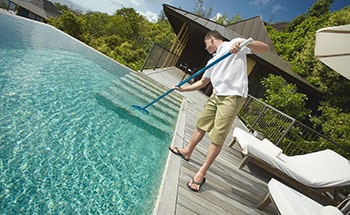
A pool cleaner robot won’t be able to eliminate all manual pool maintenance — only about 99% of it. You’ll still have to occasionally scrub the steps or parts of the wall, for example. However, instead of spending countless hours on the weekends arduously scrubbing and vacuuming your pool by hand, you’ll have more time to enjoy it.
That’s because pool robots can shorten your cleaning time to a fraction of what it used to be, giving you the glorious opportunity of having a deliciously delectable Mai Tai on your patio as you watch your mechanical friend selflessly toil for your benefit.
How Often Should I Use My Robotic Pool Vacuum
If you use your pool frequently, you should probably run your pool robot every day. If you don’t use your pool that much, running it once a week should be enough.
How Long Do Robot Pool Cleaners Last
Even the best pool robot cleaner robot on the market won’t last forever. The longevity of a robotic pool cleaner varies depending on the frequency of use and how well you maintain it. The average lifespan is approximately five years. However, if you meticulously maintain your pool robot vacuum, you might be able to stretch that time to seven years (as some users have done).
Robotic vs. Suction vs. Pressure Cleaners
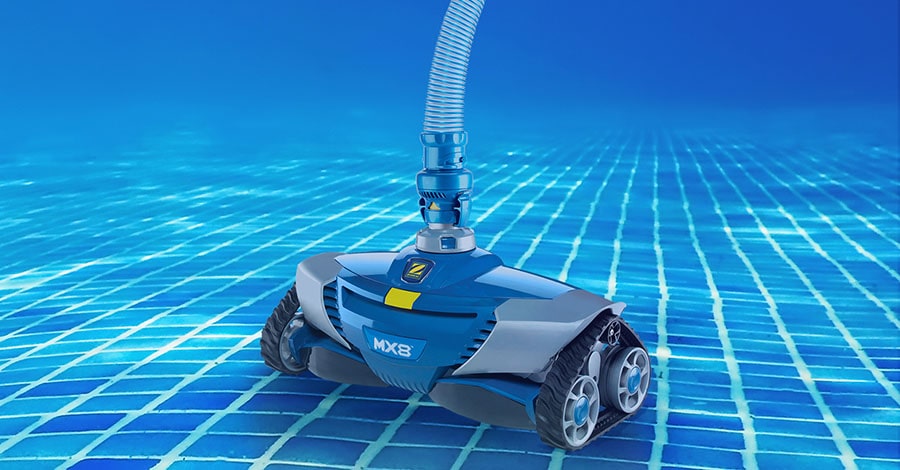
Suction-side cleaners are fantastic for pool owners on a tight budget because they usually cost less than the other types. With few moving parts to break down, maintenance is easy.
Even if you have to occasionally replace a part, it’s relatively inexpensive to do so. They’re perfect for pools that have a more powerful pump than the pool and filter need, which means there’s a surplus of energy the suction cleaner can tap into.
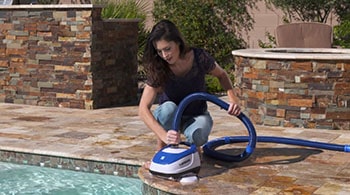
Suction cleaners attach to your pool’s primary filtration pump and use its power to move from one end of your pool to the other. Suction cleaners have a throat mechanism that allows dirt, dust, and sand to pass through but can clog if larger debris gets stuck.
This means the unit will remain inoperable until someone comes along and performs an impromptu tracheotomy on the poor thing by removing whatever got lodged in its windpipe.
If sand or silt is what you need to remove, suction-side cleaners are an excellent choice. However, if your pool is plagued with a superabundance of leaves or sticks, you should probably get another kind of pool cleaner because suction machines struggle with this type of debris.
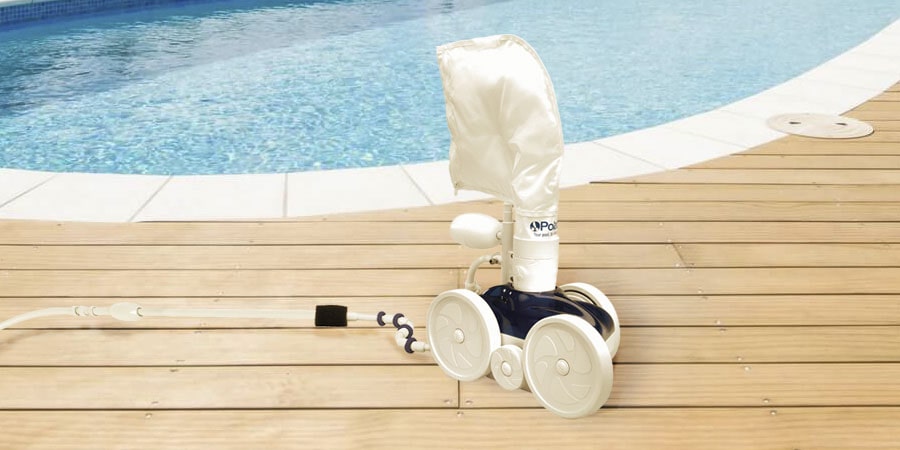
Pressure cleaners don’t use your pool’s filtration system to get rid of debris. Instead, they use a filtration bag to capture all the unsightly flotsam and jetsam detracting from your pool’s carefully cultivated aesthetics.
Pressure-side cleaners aren’t as expensive as robotic pool cleaners and are relatively easy to maintain. They attach to one of your pool’s return jets and get their power from the water returning to the pool via an existing pressure-side line.
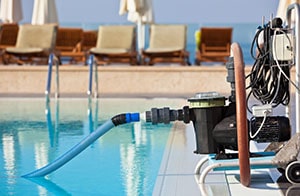
Unlike a suction-side cleaner, you won’t have to empty the pump basket or backwash the filter to keep your pool’s equipment in good working order. The internal filter bag reduces stress on your pool’s pump and filter, saving you buckets of cash down the line.
However, there are drawbacks. For example, although they’re terrific at picking up medium and heavy debris, they’re not so good at capturing fine particles or tiny scraps of trash. This stuff tends to flow right through the filter bag, where it gets trapped up by the pool’s filter.
Another downside is these cleaners often require a booster pump, and not every pool has the plumbing to accommodate this type of setup. Also, you’ll incur additional electricity costs by running a second pump.
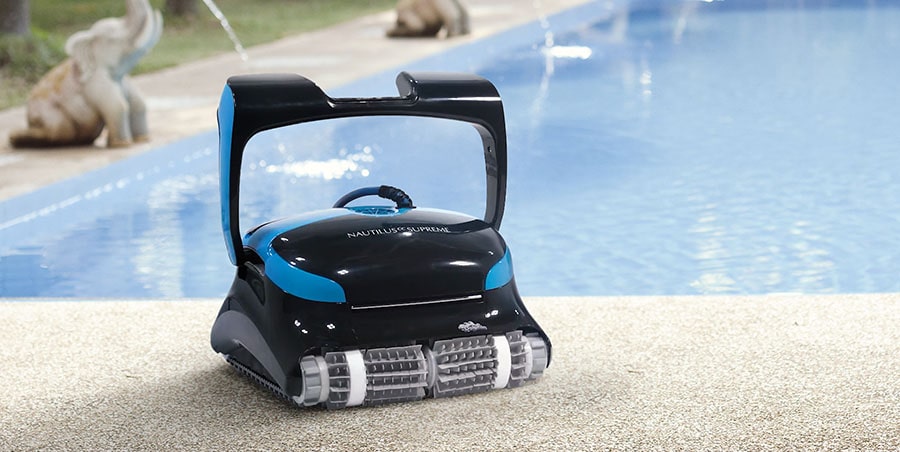
Having a robotic cleaner to defend your pool from invading armies of aqueous junk takes pool maintenance to a whole new level. These devices not only take a tremendous burden off your pool’s dedicated filtration system (saving you tons of money in the process), they also save you from the horrors of laborious manual work.
What’s fantastic about pool cleaning robots is everything needed to restore your pool to a state of crystal clear cleanliness is contained right inside the unit. This makes them fully autonomous cleaning machines that won’t place a lot of stress on your pool’s dedicated pump and filtration system. Simply plug your bot in and watch as it goes to town on all the dirt, filth, and grime that pools seem to magically attract.
While a robotic pool cleaner can be expensive, the long-term savings more than make up for the initial monetary outlay. For example, having a robot to hungrily suck up all the disgusting debris that your pool’s dedicated filtration system would otherwise choke on saves on expensive equipment repairs.
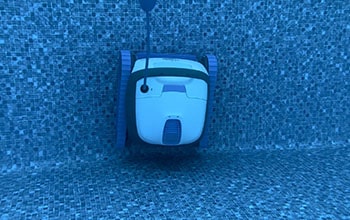
You’ll be able to sock away even more of your hard-earned cash because you won’t need to hire expensive pool boys to do the work for you. Pool robots are also exceedingly energy-efficient, helping to reduce your overall power usage and costs. This makes them environmentally friendly.
With an ever-vigilant robot patrolling for floating fragments of organic matter and algae stuck to the walls and bottom of your pool, you won’t be using manual brushes much anymore, if at all. The virtually maintenance-free design of robotic pool cleaners makes them an excellent choice for pool owners everywhere.
Types of Pools
Whether it’s pools with vinyl liners, or gunite or plaster pools, most robotic pool vacuums can tackle any kind of pool surface. However, sometimes a robot pool cleaner is made specifically for either in-ground or above-ground pools.
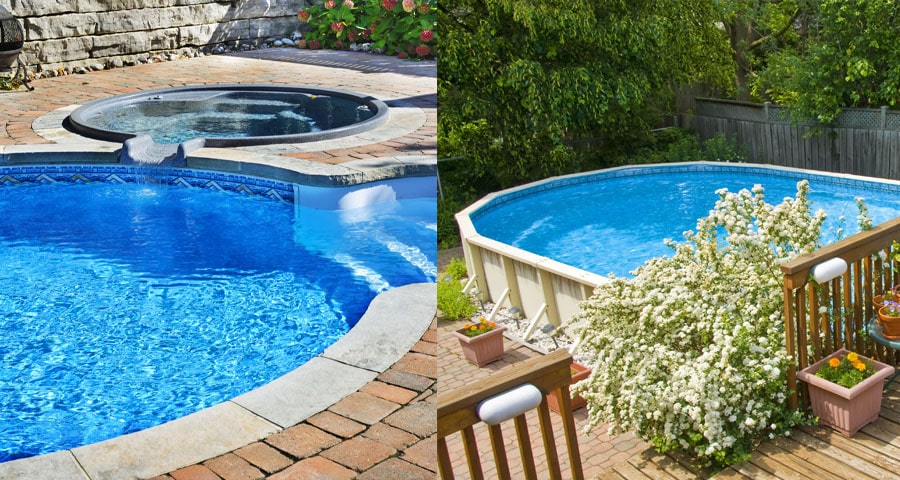
You’ll need a robotic pool cleaner that can reach all the way from one side to the other without having to unplug it from one power source and connecting it somewhere else. Your power supply must also be 12 feet from the pool’s edge. Make sure you know your pool’s length, width and depth so you know how long of a cord you need.
Also, if you have a vinyl, fiberglass or smooth tile pool, you won’t want a cleaner with a rough brush. Instead, you’ll want a bot with a soft, grippy PVC brush.
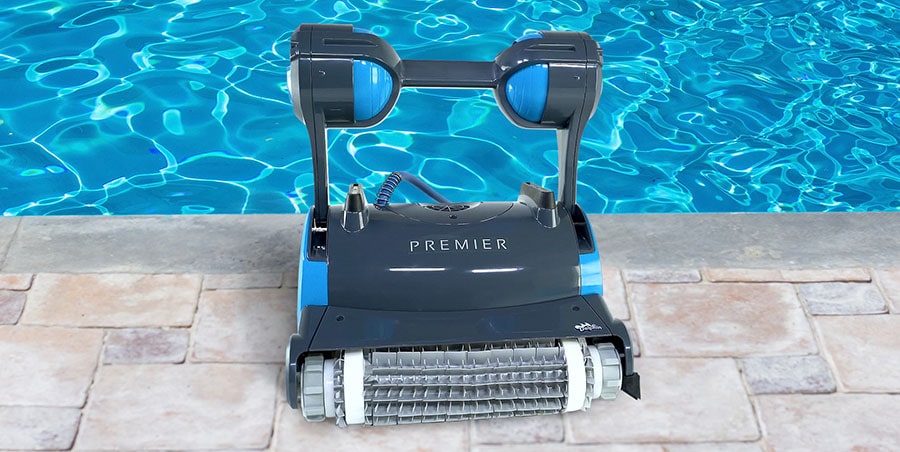
Depending on how much you use your pool and what your budget is, you may opt for a pool cleaner that only vacuums the pool floor. A pool vacuum robot sometimes doesn’t come with brushes, which means its cleaning capability is going to be somewhat limited. However, these types of bots are often the simplest to operate and are the cheapest.
However, the best pool vacuum for you is probably one that can clean every pool surface, including the floor, coves, walls, and waterlines. Because these cleaners will likely have rotating brushes, tank-like treads, and other high-tech features, they’re going to be more expensive.
Browse our reviews of the best pool robots to find one that fits your budget and pool cleaning needs!
How We Test Robotic Pool Cleaners
We meticulously analyze the performance of robotic pool cleaners by running each one through a six-hour cleaning cycle in a swimming pool best suited to that model’s use. We start the rigorous process by cleaning the pool and filter before dumping a precisely measured amount of contaminants in the water, such as leaves, pebbles, and twigs. Then, we set up and place the bot in the water according to the manufacturer’s instructions.
We meticulously record the number of times the unit gets stuck and what caused the stoppages. We measure how much debris it collects and how good it is at scrubbing away stubborn debris to assess cleaning performance. We look at how simple it is to clean all the junk out at the end of a cleaning cycle. We also look at anything else directly related to the user experience, such as the smartphone app and voice assistant compatibility.
However, we don’t stop there. We pore over hundreds of reviews on manufacturers’ websites, forum posts, and other places to see what buyers really think of their pool-cleaning machines. Most importantly, we update our buying guides at least once a year, so you always have the latest information at your fingertips.
Best Robotic Pool Cleaners of 2023 – Ratings & Reviews
Why Buy a Robotic Pool Cleaner
You have several options when it comes to pool cleaning. If you can afford to shell out big bucks, you can always go with an expensive pool cleaning service. However, many pool owners are either unable or unwilling to fork over that kind of cash. Some owners might decide to manually clean their pools. This means laboriously scrubbing with brushes, and painstakingly using nets and vacuums.
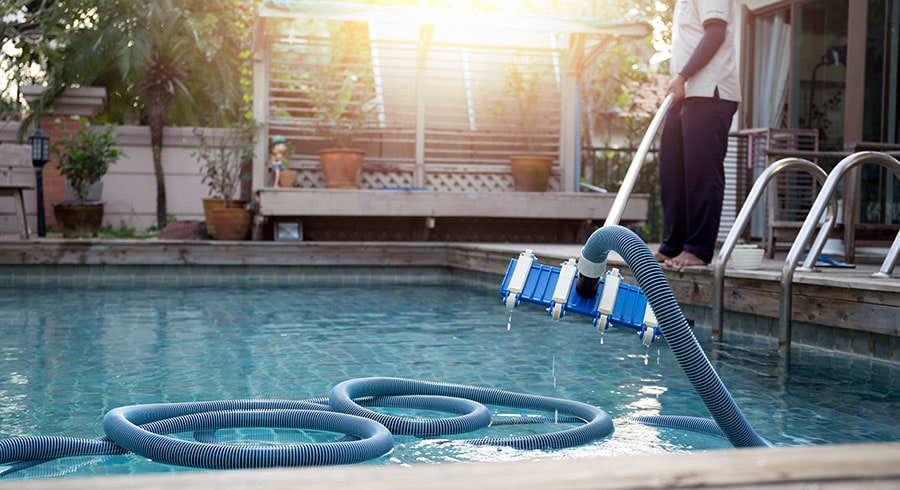
A way to clean your pool that’s not time-consuming and overly expensive is by deploying automatic pool cleaners to get rid of the aquatic crud. Pool vacuum robots tend to be the most expensive, but not always. Robotic pool cleaners are also the least labor-intensive of the automatic cleaners. Here are a few reasons to invest in one:
- You don’t have a lot of spare time. You don’t have a lot of spare time. If you’re working full time and raising a family, you’d probably rather be in the pool when you get some time off than cleaning it.

- You have health issues. Manual cleaning can be excellent exercise. However, all that bending over and scrubbing can be a painful nightmare if you have a bad back or other physical limitations.
- You want a healthier pool. A good robotic cleaner has just the right scrubbing and filtration power to remove things you can’t see with a regular pool vacuum. Those with smart navigation ensure every nook, cranny, and crevice of your pool gets a thorough cleaning.
- You want to prolong the life of your pool pump. Many pool cleaners and vacuums rely on your pool’s pump to power them, which puts extra strain on it and your pool filters. A robotic cleaner uses its own power source and filters, which prolongs the life of your pool’s dedicated equipment.
- You care about the environment. A clean pool means you’ll need fewer chemicals, which makes for a reduced carbon footprint. Also, robotic cleaners have superior energy efficiency.

What To Consider Before Buying a Pool Robot Vacuum
When looking for the best pool robot cleaner, what you’ll buy will depend on your pool type, its features, and how much cleaning you’ll need. To help you make an informed buying decision, it’s a good idea to write down all the features you want in a pool robot. That way, you can easily refer to this list to help you find the best one that also fits your budget.
Type of Pool
While robots are most often deployed to clean inground pools, some models can also clean the floors of above-ground ones. However, most robots won’t be able to clean the sides of above-ground pools. Also, some bots are better at getting into the sinuous corners of irregularly shaped pools. That’s why you need to keep your pool shape in mind when looking at pool possibilities.
Size of Pool
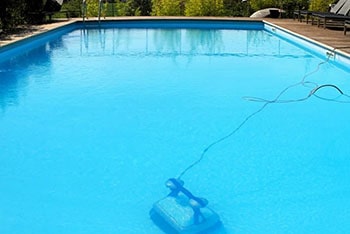
Check the maximum pool size the robotic cleaner is designed for. Cord length on the machine will determine how far it can reach across your pool. If it’s not mentioned, see what the length of the cable is and subtract 10 feet. The larger your pool, the longer the cord you’ll need. If it’s too short, you may have to move the power supply from one side of the pool to another.
Most in-ground robot cleaners come with a 60 foot cable, which means they can cover a pool up to 50 feet long. Most above ground robotic pool cleaners have a 40 feet cable, meaning they can clean pools up to 30 feet long.
Steps, Stairs, Walls, and Waterlines
Pretty much every pool cleaning robot can tackle the pool floor with no issues. However, some can’t clean stairs and steps or climb walls. Others can’t scrub the waterline. Generally the more capabilities a cleaner has, the more expensive it will be.
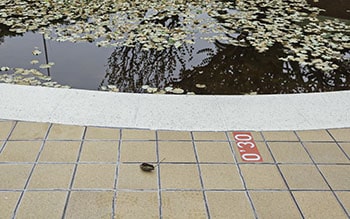
The Debris Your Pool Collects
You’ll get better results from a pool-cleaning robot if you consider the kind of debris that lands in your pool. This is wholly dependent on your climate, geographical location, and landscape. All these factors contribute to the types of junk that end up floating around in your pool.
For example, if your property has a lot of trees on it, you’ll probably want a robot that has a large filtration basket. This way, it won’t fill up too quickly, saving you the annoyance of having to empty the device every two seconds. If your pool is plagued by finer debris such as pollen or dust, think about buying a robotic pool cleaner with ultra-fine filters.
Features To Consider
Here are some of the features that make the difference between a merely okay cleaner and a truly exceptional one:
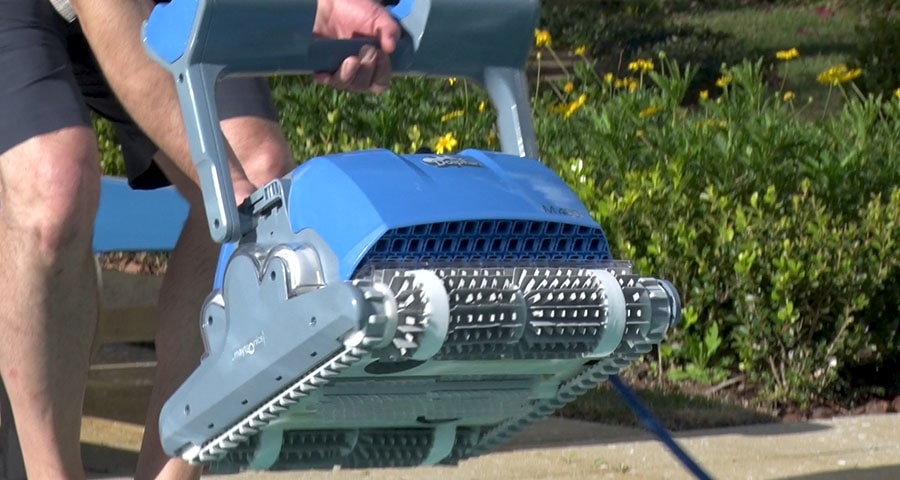
Machines that have active scrubbing can do a better job at dislodging debris from pool surfaces than machines that don’t have this capability. Some cleaners only have suction power, which means you’ll have to do all your brushing manually.
Smart Scanning Systems
Smart scanning systems use advanced algorithms and mapping technology to plot the most efficient cleaning path. These can be great for oddly shaped pools so that the cleaner doesn’t end up going over the same area multiple times, thereby wasting energy.
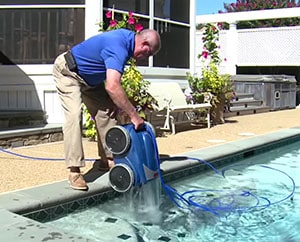
Weight of Unit
How much the unit weighs is also crucial since you’ll need to lift it out of the pool. Keep in mind that the water and collected debris make it heavier. Wheeled caddies can be a real backsaver because you can roll the cleaner from the storage area rather than carrying it.
Anti-Tangle Swivels
Anti-tangle swivels keep the cord from getting all tangled up. This is a good thing to have if you’re not going to be at home when the unit is running.
Easy to Clean Debris Canisters
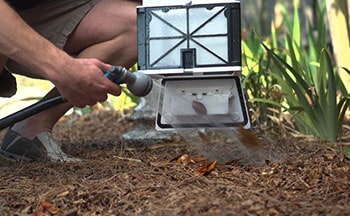
A robot’s filtration system is crucial to cleaning performance. You can either get a unit with a cloth filter bag, or one with a basket that has a fine mesh screen for filtering. Keep in mind that filter bags are more challenging to clean and need time to dry. On the other hand, filter baskets or cartridges only require a quick hosing down.
Some bots have multimedia capability, which means they come with multiple filters for different types of debris. For example, one model could have a bag for acorns and leaves, and a basket to capture smaller scraps. Other models have cartridges for fine and ultra-fine debris that fit in with each other.
Machines with archaic technology typically provide filter access from the bottom. On these models, you need to turn the unit over to get to the cartridge or bag. Top-loading models are easier to maintain.
Features That Are Nice To Have
Other features that are nice to have but not really necessary are a remote control, programmability, and Bluetooth and Wi-Fi capability. A remote control allows you to navigate your bot to a specific area for precision cleaning.
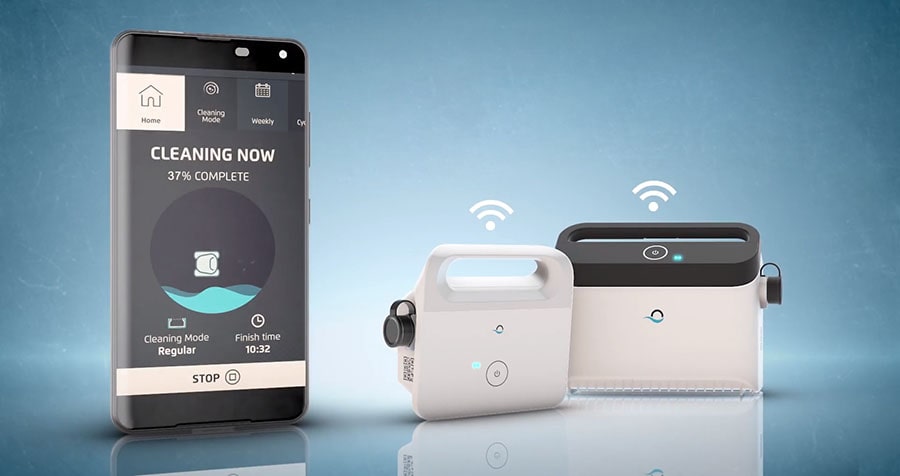
If you want to run your cleaner on a set schedule while you’re not home or at night, being able to program weekly cleaning cycles certainly would be beneficial. However, if you do that, you’ll have to leave it in the water all the time. This means that the chlorine and other pool chemicals could shorten its useful life.
What Are the Drawbacks to Pool Robot Cleaners
As nice as they are to have for saving time and effort, there are a few cons when it comes to pool robots:
- Price: Pool robots are usually the most expensive type of automatic cleaner. The cheapest ones may be about the same price as a mid-range pressure or side-suction cleaner. However, these models don’t have nearly as many features and tend to break down more often.
- Maintenance: With all the moving parts, there’s more to break and replace on a pool robot. In fact, the most common complaints when it comes to robotic cleaners are all about them suffering mechanical malfunctions. That’s why you should probably purchase a machine with a decent warranty, including an extended warranty if it’s available.
- Filter cleaning: Unless you want to waste money on disposable filters, you’ll need to clean out the filter bags or cartridges after every cycle. If your pool is big and gets used a lot, you’re going to have to clean them with annoying regularity.
- Tangled up cables: Because anti-tangle swivels don’t always work, it’s a good idea to watch your unit the first few cleaning cycles to ensure the tangle-free swivel is doing its job.

- Can damage some vinyl surfaces: If you have a vinyl-lined pool, make sure the cleaner is compatible with it. Some of the brushes can scratch the ink or remove the patterns on the vinyl. Always make sure your vinyl is in good shape before using a pool robot with brushes.
- Can’t swim with it in the pool: All pool robots are grounded with GFCI plugs that are supposed to shut off at the first hint of any electrical imbalance. However, there’s always a risk of electric shock any time you have electricity and water together. That’s why while it’s running, you should keep everyone out of the pool to make it safe for swimmers.
Pool Cleaning Robot Maintenance
If you spend several hundred bucks on a new automatic pool cleaner, you probably want to ensure it lasts as long as possible. Unlike simpler pool cleaners such as brushes and nets, robotic pool cleaners need a little extra TLC to keep them functioning at their peak condition.
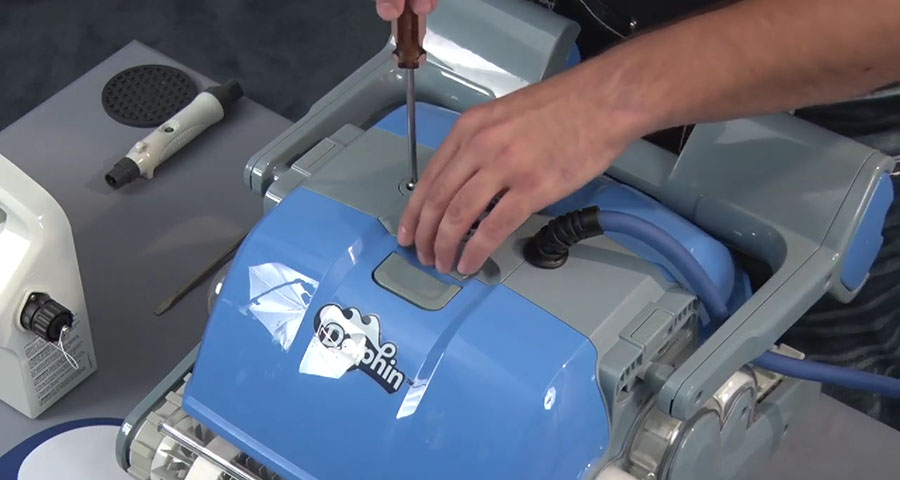
The best pool vacuums will keep going like the Energizer Bunny so long as you maintain them properly. This means always adhering to the guidelines in the owner’s manual. Keep it handy for reference.
Here are some general tips to keep your pool vacuum robot running smoothly:
- Remove the robot from the pool at the end of the cleaning cycle. Prolonged submersion can damage the motor, and there’s always a risk of electrical shock if you swim with it in the water.

- Thoroughly drain all the water from the cleaner when you take it out. Your owner’s manual should tell you how. If not, look for videos online.
- Clean the unit after each cycle, including clearing brushes and wheels of debris, and emptying and rinsing the filters.
- Replace any worn brushes or filters ASAP.
- Store your pool robot out of direct sunlight, and protect it from the elements. The power supply can sustain damage if exposed to torrential rain or other inclement weather.
It may not sound like fun to keep up with a rigorous pool maintenance routine. However, skipping any of these steps can cost you a lot in both money and time.

These quick tips and hints come from customers who’ve used the products listed above. They might help you if you need some troubleshooting.
- If debris tends to fall out when removing your cleaner from the pool, try either removing it really quickly or really slowly and keep it upright at all times.
- If you have a beach entrance style of pool, a robotic cleaner may get flipped over if it’s climbing a nearby wall. The water at the entrance may be too shallow for it to turn itself back over. Most cleaners have auto-shut off if this happens.
- To help prevent cord tangling, try stretching the power cord out straight and leave it in the sun for a few hours.
- Make sure the filters are completely enclosed with the door fully locked down, or the cleaner may not run.
- Don’t neglect the usual pool maintenance with regular brushing, testing water pH and chemistry, etc. There’s only so much your pool robot can do. If your pool is neglected and filthy, you need to manually clean it first, then use the pool robot for maintenance cleaning.
- The tracks on the rollers will stretch and loosen after a while. If you notice it’s not climbing like it used to, try replacing the tracks.
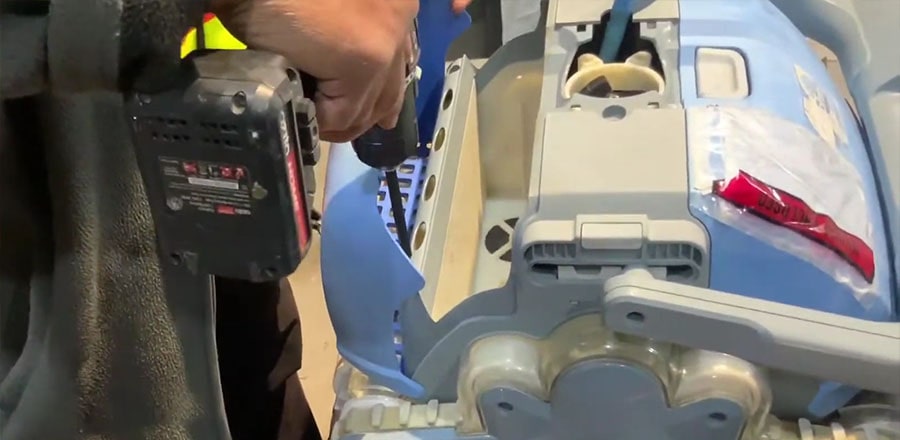
Unfortunately, every pool cleaner is going to break down now and then. If your unit is still under warranty, call the manufacturer’s support hotline to see if the company will pay to fix the issue. If not, see if the problem is something you can take care of yourself before calling the professionals.
If your pool cleaning robot isn’t working, follow these steps:
Check the Power Supply
Check to make sure that the power cord isn’t damaged. If it isn’t, ensure that the power cord is firmly plugged into the power supply transformer, which should be plugged into a GFCI outlet.
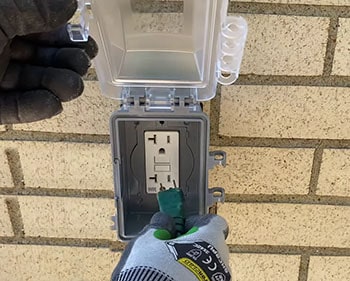
The power supply will have an indicator light telling you if power is flowing through it. If electricity is getting to the power supply, but the cleaner isn’t moving, the problem lies elsewhere. The power cord could have a short, meaning the wires have broken away from the connection inside the rubber casing. This frequently happens at a point near the cleaner where the stress on the cord is the greatest.
Wires can break if a user exerts too much force when pulling on the cord to remove the unit from the pool. If the power cord is in good shape, check the resistance of the motor using a test meter.
This will tell you if power is reaching the motor. If it is and the motor isn’t working, it looks like you might have to install a new motor.
Mobility Issues
If your robot is slow or doesn’t climb walls the way it should, this could indicate cracked bearings, old brushes, or worn-out drive tracks. It could also mean there’s debris stuck in tracks, brushes, or the impeller.
The debris basket could be full, which could interfere with the unit’s ability to move around your pool. If none of these things are the source of the problem, lift the unit partially out of the water to see if it’s sucking air. If it isn’t, it might need professional attention.
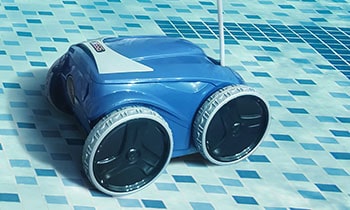
Getting Stuck
Some robotic pool cleaners have an annoying habit of getting stuck behind ladders and handrails. A relatively inexpensive ladder guard can help prevent this problem from occurring. You can also try adjusting the cord length or moving your control box to a different location.
Leaving Areas Untouched
If your robotic cleaner leaves some areas untouched after you program it for an automatic cleaning cycle, it might be that the cord doesn’t have enough slack. The cord needs to have enough length to reach every part of your pool.
Who are we
Our resident pool expert, Luke Reed, has had a burning passion for swimming as far back as he can remember. Even as a little kid, he was always the first one in his backyard pool and the last one out.
Luke channeled this obsession in high school by becoming a member of his high school swim team. He was ecstatic to discover he had a natural aptitude for the sport. Before he knew it, a profusion of swim trophies graced his living room mantel.
Luke received a BS in Civil Engineering from Georgia Tech in 1998. His first job out of college was with the Georgia Department of Transportation’s Bridge Maintenance Program.
These days, you’ll find Luke passionately engaged in the work he was born to do: residential pool construction. His aquatic masterpieces run the gamut from luxurious infinity pools to small family pools. Even though he is a master pool designer, one of his biggest joys in life is teaching homeowners the ABCs of pool maintenance.
Luke makes his home in Tucson, AZ, where his entire family shares his joy for swimming. His keen expertise is one of the driving forces behind this website. His mission is to make pool maintenance as easy and stress-free as possible. That way, pool owners can spend more time reveling in the unparalleled joy of swimming and less time cleaning their pools.

Pool Maintenance Tips & Tricks
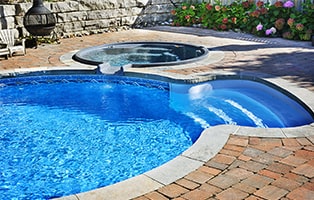

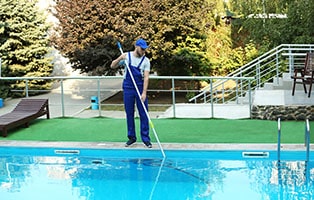
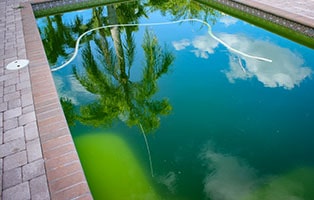
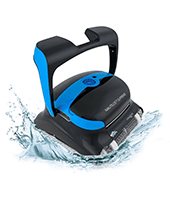

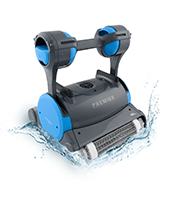
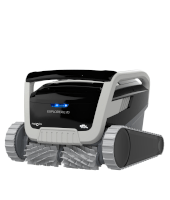
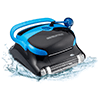
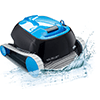
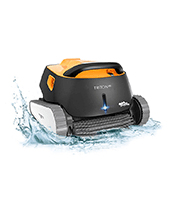
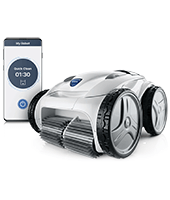

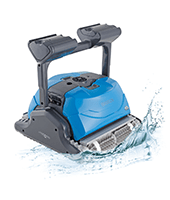
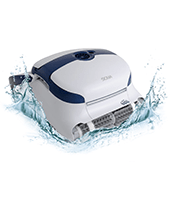
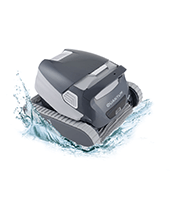
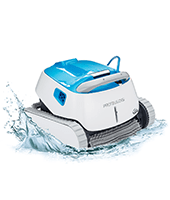
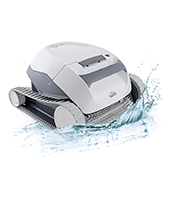
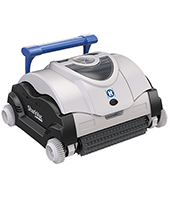
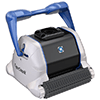
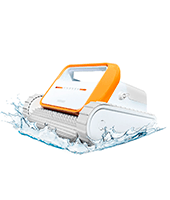
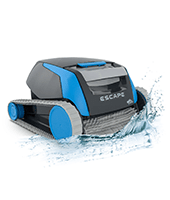
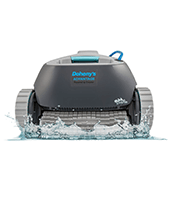
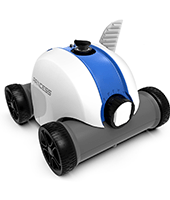
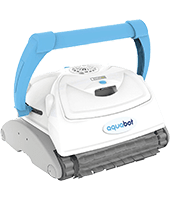
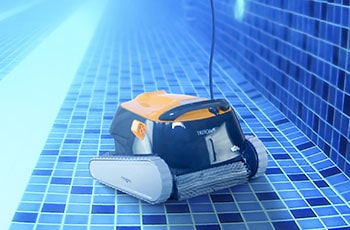
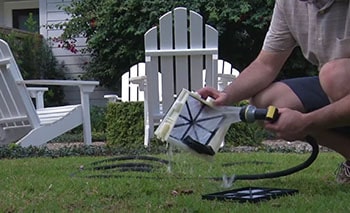
Hello, I am looking for a flat robot or a method that can clean the floor of the axe/storage area of a submerged roller shutter when the shutter is closed on the pool. I am unable to find any robot on the market that is small enough to fit through the access of the axe framework. Do you have any suggestions please?
Looking for a rootic cleaner that can clean not only the pool’s bottom surface but also a seating ledge that runs along 2 sides of the pool. Pool itsef is small, about 15 ft square. Do you have a recommendation for this specific type of cleaning?
I had a Dolphin Diagnostic for many years that I was very satisfied with , it had a cloth bag filter. Unfortunately it no longer is working so I replaced it a Dolphin Natules. It uses filter plates and will not pick up fine debris. I can not find a cleaner that uses a cloth bag. Will the Dolphin Primer solve my problem? Is there another option for me?
Very interesting reading. I live in France ad we have Dolphin T35 online or shop Dolphin 300 300 Euros more. Do you know the difference between them?
Hello , what Dolphin cleaner is best with minni pebble surface ? I have not seen a review for that question ?
Thanks , for your input,
Dennis
Hi, what are your thoughts on the Blue Torrent MyBot inground robotic cleaner? I have a 40 foot vinyl pool. Thank you
I’m thinking of getting a robotic pool cleaner. However, it rains quite a bit in my neck of the woods. Will water pelting downwards from the heavens damage the power source?
Greetings, Jessica! While power supplies for most robotic pool cleaners are water-resistant, they’re not waterproof. This won’t be enough to protect it from a torrential downpour. For optimal protection from the elements, it’s probably best to keep a cover over it when you’re not using it.
Some people keep their power unit underneath a customized plastic container with a hole cut in it so the cord can fit through. If you do this, ensure that air can circulate around the unit so it doesn’t overheat.
I hope this was helpful!
Which robotic pool cleaner lasts the longest? I’ve had several bots in my years as a pool owner, and most of them didn’t last as long as I would have liked.
Greetings, Mark! Sorry to hear about your horrible luck with pool-cleaning bots. With regular maintenance, the average robot should last three to five years. While I can’t predict how long a particular unit will last, I would go with the Dolphin Nautilus CC.
I’ve always been impressed with its exceptional durability, meaning you should get years of use out of it.
Can you tell me if familiar with CRX Jacuzzi if it lasts the usual 3-5 or are you aware of problems? I can’t find much info & deciding between repairing our Triton or buying a Dolphin . I like the light weight & especially that it comes to tip of pool wall for emptying . Tritium does not but which others do? So much easier fir me to lift out. We thought it seems not as sturdy ( more plasticky) but it does well except shuts off at 1.5 hrs
Thanks if u can reply today as we may return it but value your opinion .
Hello! How intelligent are robotic pool cleaners? Some people say that they have advanced electronic brains. Other people say they just randomly zigzag around your pool until they somehow manage to hit every spot. Who’s right, and does it even matter?
Hi, Susan! Thanks for your question. While a pool-cleaning robot doesn’t have as much artificial intelligence as one of those robotic dogs manufactured by Boston Dynamics, it’s still pretty intelligent.
A robotic pool cleaner does something I like to call “smart pool mapping and navigation.” This means it uses advanced algorithms to quickly scan the pool to learn its shape and size. That way, it can plot the most efficient cleaning path, covering every inch of your pool in the least amount of time.
This allows the robot to not only do a better job at scrubbing every nook, cranny, and crevice of your backyard swimming hole, but it also saves a ton of energy. That’s because, unlike Macbeth’s wife, the bot doesn’t keep going over spots it already cleaned.
I hope this was helpful!
Hello,
Of all the robotic pool cleaners on your 2021 list, are there any that should not be used on an in-ground pool with a vinyl liner?
Thank you.
Hello, Chris! I hope you’re having a fantastic summer! The Dolphin E10 and Escape are only for above-ground pools, so you shouldn’t use them in inground ones.
Be careful of patches. One user I know complained that the Hayward SharkVac tore open a patch that they had on their vinyl liner. This created an enormous hole that flooded their backyard, and the pool owner had to replace their liner.
The rest of the robotic pool cleaners on the list do a fantastic job getting all the gunk off vinyl liners. Keep in mind that if a robot cleaner is brand-new with no broken parts, it usually won’t put holes in a liner. However, if your robot gets hung up on obstacles like steps and goes undetected, it could conceivably do some damage.
Some vinyl patterns are susceptible to minor scratching when objects repeatedly rub up against them. This includes brushes, toys, floats, chlorine dispensers, and sometimes even robotic pool cleaners that get stuck in one spot.
Kevin, are you paid or sponsored by Dolphin?
Jon, No!
I’m a little afraid of purchasing a robotic pool cleaner because I’m hesitant to put something that runs on electricity in the water. How safe are these things? Has anybody ever gotten electrocuted on one of them?
Greetings, Blaine! To my knowledge, nobody has ever gotten electrocuted on a robotic pool cleaner. You’re safe if you use a GFCI (Ground Fault Circuit Interrupter) electrical outlet. These outlets offer better protection than standard outlets.
Suppose the GFCI detects any sort of change in the electrical flow in the circuit. In that case, it immediately cuts off the flow of electricity. For example, let’s say that there’s a defect in the robotic pool cleaner, and an electrical current makes its way into the water. The GFCI senses this right away and cuts the power, keeping everyone safe.
Besides, the robot only uses 24 volts of electricity. This isn’t enough to electrocute someone—only to give them a slight shock.
I frequently follow your blog and it is always worth reading. I have tried to create a blog of my own and I try my best try to make it as good as yours.
Thank you for creating value for the community.
Why does Dolphin list some models as In-Store and some as Online? Are some of them duplicates? Or are In-Store ones supposed to be better?
I loved the cleaning ability of my Dolphin M500 at my previous home. But I hated the work of lugging it out of the water. Do I just need to look for a lighter weight model, or do some cleaners do a better job of empyting the water before you haul them out?
Hello, Traci! The Dolphin M500 weighs 22 pounds, and there’s no quick way to remove the water once its cleaning cycle is finished. I think it might be time to invest in a model that has a fast water release system. A pool robot that has this feature is the Dolphin Triton PS. It’s lightweight, weighing only 16.5 pounds.
As for your second question, I’ve often wondered about it too. Whenever I ask, the manufacturer always says something along the lines of “That’s just the way we choose to market the product.” My guess is that some models sell better in store and some online. I hope this helps!
For a Fiberglass Pool 29′ long, just under 6′ deep.
Polaris or Dolphin?
I see that they use different wheels
it is worth the extra $$ for an upgraded model?
My pool has a cement bottom with fiberglass side. Where the fiberglass meets the cement there is a 6″ flat ledge. Will a a dolphin
I am looking to purchase a new robot pool cleaner
I live in NM and I get quite a bit of fine dust out here I’m new to pool. Just built my pool. I had the zodiac mx8 it’s nice but it’s kind of complicated for my wife to put it together and mess around with the valves. So I’m looking into a robot. Saw some good reviews on Dolphin Nautilus CC Plus
Greetings Danilo,
Yes, the Dolphin Nautilus CC Plus is one of the simplest pool robots to both operate and clean. You can even use the MyDolphin Plus app on your phone to set a weekly schedule for your pool-cleaning bot. This means you can program the unit to clean your pool on specific days and at specific times, even when you’re not at home. What’s more, its ability to suck up fine dust is second to none.
Hi Kevin, I am looking to purchase a new robot pool cleaner. My old one struggled picking up Acorns from our Oak Tree. Can you suggest a cleaner that picks up Acorns without a struggle?
Hello, David,
The Dolphin Nautilus CC Plus has a well-deserved reputation for sucking up acorns. However, because they must fit through the intake port, acorns can’t be much bigger than an inch or so. I hope this helps!
Hi Kevin-
My Dad used Aquabots for years on his pool in Florida. But they have been breaking down alot. I want to find an alternative. People really seem to like Dolphin. What would you recommend for a 60 foot, regularly shaped, in ground pool? Need a bot that can handle the waterline too.
Quantum? Sigma? Premier? Hard to decipher the benefits of these higher end models.
Thanks!
Aquatically Challenged,
Brenner
Hello, Brenner! The only pool cleaning robot in our list that can tackle a 60-foot pool is the Polaris F9950 Sport. It has a 70-foot cord, enabling it to reach every area of larger-sized pools. The F9950 also cleans the waterline. I hope this helps!
For the robotic cleaners that offer “remote driving”, I haven’t seen any descriptions that explain what kind of connection is used for that. I’ve seen mentions of bluetooth and wifi, which would make sense out of the water, but neither kind of signal works underwater. How do they get an app to remote drive while the device is underwater? Or am I misunderstanding what remote driving would mean?
Also, if a unit can handle a “50-foot pool”, does that mean 50 foot radius from where it goes in the water, or total length? I have a 54-foot lap pool, but the power source and point of entry will most likely be roughly halfway in between. Would a 50-ft device be able to handle that?
Hello Mark! You’re right—Bluetooth doesn’t work all that well underwater because the signal becomes drastically attenuated due to the immutable laws of physics. The good news is that your Bluetooth-enabled device doesn’t have to pair with the robot itself because it pairs with the above-water power supply, which then controls the robot.
As for your second question, “50-foot pool” means total length. If your power source is at the midpoint of your pool’s length, your robot shouldn’t have any problem cleaning every cranny and crevice of your pool.
I hope this helps!
I’m thinking of getting the Dolphin Nautilus CC Plus because I love the idea of having a little robot friend do all my pool cleaning for me. Can it really clean my pool in only two hours?
I’m thinking of getting the Dolphin Nautilus CC Plus because I love the idea of having a little robot friend do all my pool cleaning for me. Can it really clean my pool in only two hours?
Hi,
We are putting in a beach entry style pool. Is there any Dolphin vacuums that will work?
Beach entry pools can be a little tricky for pool robots. According to the manufacturer, all Dolphin models are supposed to be “beach entry compatible.” However, most robots can’t do the entire shallow area of this kind of pool because the top of the unit must be underwater for it to function.
You’ll probably have the best results with the Premier. This model will clean your beach entry pool until it’s in approximately four inches of water and then turn around. Unfortunately, you’ll probably have to manually clean this part yourself.
We have a dolphin, and it is awful. Used to have a Hayward that worked much better.
How’s it going, Luke! I’m a 78-year-old woman who can’t get around as well as I used to be able to do. I want to purchase a robotic pool cleaner. However, I’ve heard some of them can be a real pain to retrieve from the pool. I’m looking for a high-performing machine that’s also lightweight. What would you recommend?
Hi, Sheila! Yes, there are some real hefty behemoths out there when it comes to robotic pool cleaners. The most lightweight yet effective robots on the market are the Dolphin Escape, Dolphin Advantage, and Dolphin E10.
They all happen to weigh 13.8 pounds, so hopefully, whichever one you buy, you’ll be able to easily lift it out of your pool after it’s done cleaning.
I hope this helps!
Hello Luke,
Thank you for this information.
Wondering what would be best machine for my pond.
Got 3 quite large concrete ponds with no vegetation & no fishes.
Deep is from 30cm- 50cm in the most.
Just pond for the look.
Because of my location there comes a lot of sand in it – that is quite have to shovel out of it.
What machine would be best for me to use?
Hello, Rakel! If you’ve got so much sand that you’re literally shoveling it from your concrete ponds, I’m not sure a robot pool cleaner is going to help. However, if this is only an exaggeration, I would recommend the Dolphin Premier.
This is an excellent unit that’s perfect for all pool types, from gunite to tile and fiberglass, and of course, concrete.
The Premier comes standard with three filter options: bottom-load fine cartridge filters, ultra-fine cartridge filters, and an oversized fine filter bag. Depending on the size of your sand granules, either the fine or ultra-fine filters should do the job.
I hope this helps!
You are not listing the Dolphin Nautilus CC Supreme in your 2021 rank list of pool robots, even though it seems to offer advangates over the #1 rate CC Plus and #2 rate Dolphin Premier. Why have you left it out of your rank list of Pool Cleaning robots? Have there been problems with the CC Supreme that make it less recommendable than the others, or is it just the high price?
Hello, Armin! That’s a terrific question. The Dolphin Nautilus CC Supreme is a newer model that’s ranked in the number one position on our list of alternatives to the Dolphin CC Plus.
Because it’s newer, we felt it was better to list it as an excellent alternative to the older model. But don’t worry, if the CC Supreme keeps up its superlative performance, it’ll soon share top billing with its higher ranked siblings.
Take care, and I wish you happiness and sunshine!
Hello, Luke! I’m thinking about buying the Dolphin Nautilus CC Plus. The trouble is, I have an inground pool with a vinyl liner. Will this kind of robot end up tearing my liner to shreds?
Howdy, Desiree! I hope you’re doing well. I’ve never heard of the CC Plus damaging vinyl liners, so I would go ahead and purchase it. Let me know how it works!
Kevin and team, this is a very helpful report. I do have a question on setting up automatic cleaning cycles. What’s the point? I still have to take the robot out, hook up the power and put it in the pool, then take it out of the pool every time it’s used. So why do I care about automatic cycles? I don’t see that they are meaningful, in spite of the way the manufacturers hype them.
Hello, Duke!
Thanks for your excellent question. You can leave your robot in the pool 24/7 if you want to take advantage of the unit’s automatic cleaning cycles. However, chlorine and other pool chemicals’ toxic effects could cause some degradation of the plastic housing and the exterior components over time.
If you’re willing to accept this tradeoff, it’s okay to always keep your robot submerged. The best use of the automatic cleaning function is when you’re going on a vacation. The minimal amount of time your pool-cleaning bot spends underwater while you’re away isn’t going to cause much (if any) damage.
Kevin,
Would you mind updating us on best robot for leaves and junk from the trees? I’m looking at the Dolphin Nautilus CC Supreme, but I’m open to others if they are better at handling leaves since they are my main challenge. Does Dolphin Nautilus CC Supreme also offer a leaf bag?
Thanks you!
Hey Josh!
Looks like you picked the right machine.
When it comes to sucking up leaves, the Dolphin Nautilus CC Supreme is superior to other robotic pool cleaners on the market. Customers have gotten excellent results when freak storms have deposited an avalanche of foliage into their pools.
Some experts will tell you to go with a machine with a filter basket to get rid of this kind of plant matter.
While the CC Supreme doesn’t have a basket, it boasts extra-large filter cartridges and superior suction that’s powerful enough to remove virtually every leaf from your pool. Unfortunately, this model doesn’t come with a leaf bag, but why would you want one?
They’re a relic of an earlier evolutionary time and are such a hassle to clean. The good news is that you won’t need one with the extra-large filters and superior cleaning ability of this machine.
Keep in mind that no robot pool cleaner can remove leaves floating on the surface—only those that have sunk to the bottom or have gotten stuck to the walls. For surface leaves, I recommend using a skimmer before you deploy the CC Supreme.
If you have many leaves to vacuum up, you’re going to need to clean the filters every two hours.
I hope this helps!
Given the fact that so many pools now days have very shallow sections, ie splash pads, which of these robo cleaners can run in 4 to 6 inches of water?
We supposedly a have self cleaning infloor jet system. Still needs vacuuming. Will the robotic cleaning vacuums be safe to use with these pop up jets on the floor of the pool? What would you recommend?
Hi there thanks for the article – much appreciated.
I have a small (2x5x2m) but deep plunge pool with steps at each end – it doesn’t get lots of leaves but does get fine dust / particles and has smooth tiles.
Wondering what’s view on the best equipment for the job!! Thank you in advance
Are there any pool robot cleaners that can run more than once a day? My neighbor has a leafy tree right on top of my pool and it becomes a nightmare in the fall. Surprisingly I cannot find a single robot that allows me to set a schedule to more than once a day.
Thanks,
great article we are looking for first Robotic cleaner for our inground pool
Saw the Dolphin Natulius CC Supreme was best, but what about Natulius Supreme CC, at about half the price of supreme model?
Thanks for your answers to this
Hi. I bought a paxcess robotic pool cleaner on Amazon. Does a great job cleaning but I am now seeing black scratches on the bottom of the walls from the sides of the cleaner rubbing. It’s a 30k gallon indoor concrete pool and would be a nightmare to get it painted because the pool is near a lake with high water table. Do you have any suggestions one how to prevent? I do like the convenience but don’t want to damage the concrete. Thinking about pads etc to stick on the Plastic corners on the side of the brush or just filing the plastic? Thanks and very informative article
We have an L shaped pool. Our local pool store says a robot won’t work because of that. Do you believe that to be true or do their mapping systems work around it?
Kevin,
I have a vinyl pool liner and the automatic cleaners have worn the color from the water line. Can you recommend a cleaner which does only the floor and walls
Sorry to hear about the damage to your pool, Tim. That’s horrible! There really aren’t any robotic pool cleaners out there that do the walls and the floor and not the waterline. However, a pool cleaner is supposed to be improving the aesthetics of your pool. It’s not normal if it instead detracts from them by removing the color from your pool surfaces.
I would have a professional fix the damage, and then, replace your obviously defective machine with a different one. I recommend the Dolphin Nautilus CC Supreme. As I mentioned in the Buyer’s Guide, it happens to be the best one on the market right now. And I haven’t heard of a single complaint of one causing damage.
You could also write to the manufacturer to tell them about what happened. Maybe they can shed a little insight into how their product could do such a thing, or even compensate you for your troubles.
That was one very helpful article. Thanks for sharing! So I am planning on using/renting pool cleaners for business purpose, what pool cleaner would last longer if I were to use it on a daily basis on multiple pools..? or how often should I use it for it not to get damaged to quickly? Thanks in advance for your answers.
Hey, Pool Cleaner, glad you found the article helpful! I think it’s fantastic that you’re planning to start a robot-based pool cleaning business. However, you shouldn’t think about which one lasts the longest, but which one does a better job.
After all, the primary mission of any business owner is to make the customer happy. The Dolphin Nautilus CC Supreme has all the advanced features you’ll need to do a bang-up job for every one of your customers.
The Supreme has three brushes instead of two, so it’s more likely to clean more thoroughly than other robots without this invaluable feature. The center brush is particularly adept at getting rid of stubborn stains.
The center brush also helps the robot not to get stuck on the drain. I don’t know how you’re planning on running your business. Still, I assume you’re going to drop the robot into the pool and come back after the cleaning cycle’s conclusion.
You don’t want to find out, upon your return, that the robot was helplessly trapped on an obstacle the entire time. This cuts into the efficiency of your operation and could affect your bottom line.
The Supreme can also clean larger pools—up to 50 feet. So, you’ll be able to tackle practically any job a residential customer has for you.
Another fantastic thing about the Supreme is there are two separate motors—one for the suction, and one for the brushes. A dual motor system ensures that there will always be enough power for vacuuming AND scrubbing. More power for both means your little underwater grease monkey will do a much better job.
The Supreme has extra-large filters too, so it’ll trap more debris. You’ll be spending less time emptying the collection chamber, which also adds to efficiency.
It’s one of the best robots on the market for scrubbing the waterline. The waterline is one of the visible parts of a customer’s pool. Therefore, it’s imperative that it be kept as immaculate as can be.
This is also a fantastic machine to rent out because it’s a top-of-the-line premium robot with cutting-edge technology.
I believe the Supreme will last longer than most other cleaners if you’re using it commercially since this is a well-constructed, well-engineered model. As far as how often you should use it, so it doesn’t get damaged too quickly, I don’t think as a business owner you should be worrying about that.
After all, the more you use it, the more money you’ll make. So, the Supreme becomes an investment that’ll pay for itself.
Good luck with your new venture!
a tried many brands , many prices honestly without the expected results .. 2 month ago i decided to take the risk and try again ..for me i consider thes wimming pool as a part of me .. it must be always clean haha even in winter i tried this product and honestly he’s doing good till know .. i can control it by my mobile phone .. i cant say more .. it works for me at least better than other brands .. https://cleanup.expert/dolphin-nautilus-cc-supreme/ i hope i can help
My neighbor and I are thinking of buying a Dolphin robot and sharing the use and cost of a Dolphin S200. Our pools are not though of similar size and have different filtering systems.
Thanks for your help.
I have a mosaic tile pool using the salt water system and tiles from the bottom of the floor are popping up after many years of use. Before we retire, I want to make sure I buy the right robot or should I be using a robot at all? It needs to be a robot that can be purchased in Italy. We have an old robot now and I am concerned it might be harming the tiles because they are often scooped up in the bag.
Coco, no robotic pool cleaner that I know of will damage your pool. I would look to other causes for your tile problem. For example, I would carefully inspect the substrate for cracks, which would cause your tiles to crack and fall off.
If your inspection fails to reveal the source of the problem, have a qualified technician check the robot on the off chance there’s a defect or a malfunction in it that’s causing the tile damage. If this fails to turn up any problems and you want to give a new machine a try, check out the Dolphin Sigma. This is one of the best robots for cleaning tiles, and it can be ordered in Italy through Amazon.
Dual brushes scrub your tiles on the floor and sides. There’s also a third center scrubbing brush that vigorously moves back and forth. All this brushing action will get your tiles sparkling clean, so they look brand new. But don’t worry–the Dolphin Sigma won’t cause properly affixed tiles to fall off.
I have lots of leaves And debris what is best pool cleaner
Georges, if your pool is plagued by a constant stream of leaves and other junk that falls from God-knows-where, you’ll want a bigger, more powerful robotic pool cleaner than normal. This would be one with a large-capacity filtration sytem that also has excellent suction. I would recommend the Dolphin Premier because it has these capabilities. Its suction rate is an impressive 4,500 gallons per minute, sufficient to remove all that nasty stuff just lying at the bottom of your pool.
The Premier also comes with an oversized leaf bag roomy enough to pick up large amounts of twigs, sticks, nuts, seeds, and other by-products of the natural world. Debris like this can wreak havoc on your pool pump and filtration system. The Premier is also terrific for sucking up leaves when you’re opening the pool for summer, or after devastating storms that deposit tons of dead foliage in your pool water.
Is there a robot pool cleaner that can stay in the pool all the time and I can swim in the pool while it is there?
Hi Mark! Thank you for your question and for reaching out. Ideally you should remove your robotic pool cleaner between cycles to clean its basket and before people swim in the pool. While we do not advise leaving any robotic pool cleaner in the pool all the time as corrosive chemicals used in pool maintenance may accelerate wear and discoloration, all of these devices are built for long-term submersion and can be left in the pool indefinitely. Additionally, while we do not advise swimming in a pool while a robotic pool cleaner is in operation given the risk of hitting the cord or robot and the generally expensive cost of these devices, there are people that readily and frequently swim when their robots are cleaning.
Would the Dolphin Nautilus CC Plus work in a 30′ above ground pool? I currently have a Dolphin E10 and the power cable twists up so badly that I am shopping for a new cleaner. You mentioned that there are some robotic cleaners for in ground and above ground pools but, I can’t find any. What would you recommend.
Thank you for sharing your experience and tips. I have a infinte pool, so what robot pool cleaner would you recommend me?
That’s a great question, Ernani. Any higher-end robotic pool cleaning robot should get the job done well. For instance, the Dolphin Premier Robotic Pool Cleaner is an excellent choice since its various attachments provide a ton of versatility, and it’s one of the best at wall climbing. That said, it’s best to consider what your specific wants and needs are and look for the high-end robot that most closely aligns with them.
Your post was very useful for me and it was a pleasure reading your post. Thank you for sharing!
Maytronics M600 recently came out. Would this be the “gold standard” of robotic pool cleaners now, or would Dolphin Premier or Polaris F9550 (or even Aquabot) still be in the running?
Hi, thanks for your question. We haven’t had the pleasure of reviewing the M600 yet, but it certainly looks promising! As far as being the gold standard, that might not be the case just yet. As we’ve seen with many of the newest robotic Wi-Fi connected devices, right after they are put on the market, bugs in the app and software will often pop up, causing more frustration than convenience.
Within a few months, however, those bugs will probably be fixed. Also, right now the price is quite a lot more than the Dolphin Premier and will likely go down after a few months. So as of now, you’d probably have a better experience for less cost with the older models.
Is the size of the pool important when choosing a robot pool cleaner? We have a 50-foot long in-ground pool.
Yes, size is very important actually (at least when it comes to robotic pool cleaners). The cleaner is limited by the reach of its power cord. Plus you have to keep the power supply 12 feet from the pool’s edge. Then you also have to consider the pool’s depth so it will reach the bottom of the deep end.
For a 50-foot pool, your best bets are the Dolphin Premier, Nautilus CC Plus, or Quantum, which all work for pools up to 50 feet. There’s also the Polaris F9550 Sport, which will work for pools up to 60 feet.
I have a Vanishing Edge pool. Are the robotic pool cleaners that climb on walls suitable or the robot will fall at the gap?
Hi, thanks for your question. A vanishing edge (also called infinity, negative, or zero edge) pool can be tricky when it comes to cleaning since you have to worry about both the main pool and the catch pool. However, most robotic cleaners should be fine in a vanishing edge pool. As soon as they reach the waterline and determine they’re coming up out of the water, they’ll stop and go back down.
It most likely won’t be able to clean your catch pool since catch pools are usually so narrow. You’ll have to manually clean that part.
Customers who have used the Dolphin Premier, Dolphin Nautilus, and Polaris F9550 Sport have all commented that they work well in infinity edge pools. Just to be safe, it wouldn’t be a bad idea to call the manufacturer of whichever pool robot you are considering.
My wife keeps saying we should get a robot pool cleaner. I’m really on the fence after using suction cleaners for the last several years. Are robotic pool cleaners really worth the money? Do they actually work as well as the suction cleaners?
Ten years ago, that would have been iffy. Like robot vacuums (ex: Roomba), robotic pool cleaners have come a long way in technology in the last decade. They’ve also become much more affordable.
In many cases, you still get what you pay for with a pool robot, so if you’re concerned about performance, opting for a premium model with an extended warranty would be your best bet. It’ll last longer and have the tech to clean more efficiently than the simpler, cheaper robots.
The Dolphin Nautilus Plus CC offers a lot of functionality for the price, so that might be a good one to start with.
I just got a Dolphin Premier robotic pool cleaner. How long should I expect it to last?
One of the downsides to robotic pool cleaners is once they’re done, they’re done. While there are a few parts that can be replaced such as brushes and filters, the electronics within can’t be replaced easily. So, you can expect between 3 – 5 years with most models.
The Dolphin Premier and other higher-end models can often last up to 8 years so long as you practice good maintenance and maintain your pool’s chemistry to lessen the chances of corrosion to the internal parts. Always opt for an extended warranty when you can, which will likely save you money if your pool robot dies young.
Hi, my neighbor leaves his robotic pool cleaner in the pool all the time, I think he said even over the winter. We do have mild winters, but his cleaner is still running after a couple years. The guy down at the pool store says that’s not a good thing to do, that we should take it out after every cycle. So, who’s right? Can I leave my robotic pool cleaner in the pool?
Thanks for your question. As far as leaving a robotic cleaner in the pool, your pool guy is right. You really should take it out and store it out of the elements after cleaning cycles and definitely over the winter, even a mild winter. Pretty much every owner’s manual will say the same thing.
While you may luck out like your neighbor and not have any issues, what you’re risking is damage to the rubber seals and plastics, hardware corrosion, etc. This is even more likely if your pool chemistry is off, which can easily happen over the winter.
Think about it this way. If you keep your car in a garage, it’s less prone to damage from rust, salt, hail, and so forth. If you leave it on for a cycle and go to work and take it out when you get home, this would probably be fine. Just take it out when you home, drain out the water, clean off the filters and brushes and store it in a dry, covered place out of the elements.
One of the best pool cleaner buyer’s guide for newbies. Thanks a lot for sharing!